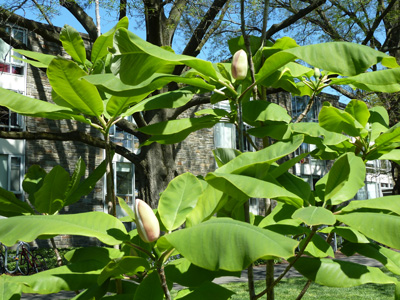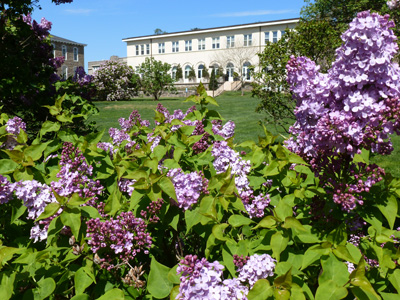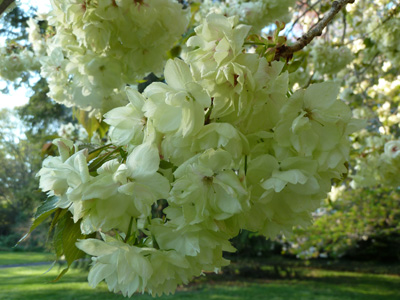Plants of the Week: April 29
 Fascinated by the bizarre? Looking for a plant your neighbor likely hasn’t seen? Consider aroids. Members of Araceae possess flowers comprised of a central spadix arising from a spathe. Western species are commonly known as jack-in-the-pulpits while Asiatic species are dubbed cobra lilies. Several species inhabit the Terry Shane Teaching Garden including A. ringens, with its flared spathe resembling a cobra about to strike to the pure white spathe of the refined and choice A. sikokianum. Plant Delights Nursery offers a diverse selection including A. tortuosum, the whipcord jack. In this particular species the spadix extends well beyond the spathe resembling a whip-like tongue reported to reach more than 12” in length! Photo credit: J. Coceano
Fascinated by the bizarre? Looking for a plant your neighbor likely hasn’t seen? Consider aroids. Members of Araceae possess flowers comprised of a central spadix arising from a spathe. Western species are commonly known as jack-in-the-pulpits while Asiatic species are dubbed cobra lilies. Several species inhabit the Terry Shane Teaching Garden including A. ringens, with its flared spathe resembling a cobra about to strike to the pure white spathe of the refined and choice A. sikokianum. Plant Delights Nursery offers a diverse selection including A. tortuosum, the whipcord jack. In this particular species the spadix extends well beyond the spathe resembling a whip-like tongue reported to reach more than 12” in length! Photo credit: J. Coceano
Garden location: Terry Shane Teaching Garden
 Magnolia cultivars tend to be the first of the season to flower and species such as M. obovata continue the display. One such species is the Japanese whitebark magnolia, a native of Japan traditionally used by craftsmen for its strong yet light-weight wood and easily worked qualities. The large leaves are also used for wrapping and cooking food. Leaves, held in whorls of 5-8 at the terminal end each shoot, lend a tropical feel to the landscape. Flowers have a strong scent and open after the leaves have expanded. Photo credit: J. Coceano
Magnolia cultivars tend to be the first of the season to flower and species such as M. obovata continue the display. One such species is the Japanese whitebark magnolia, a native of Japan traditionally used by craftsmen for its strong yet light-weight wood and easily worked qualities. The large leaves are also used for wrapping and cooking food. Leaves, held in whorls of 5-8 at the terminal end each shoot, lend a tropical feel to the landscape. Flowers have a strong scent and open after the leaves have expanded. Photo credit: J. Coceano
Garden location: Path between Willets Dormitory and Ben West House
 Few plants conjure such pleasant memories as that of the humble lilac. When asked about lilacs, many speak of a beloved grandmother or neighbor and that unforgettable smell associated with the memory. Perhaps another appeal is the fleeting beauty? The end of April is an ideal time to visit the Scott Arboretum’s collection of Syringa. Many species and cultivars such as S. x hyacinthiflora ‘Assessippi’ are concentrated in front of the Friends Meetinghouse. Did you know the lilac was the first plant planted when the Scott Arboretum was officially established in 1929? Photo credit: J. Coceano
Few plants conjure such pleasant memories as that of the humble lilac. When asked about lilacs, many speak of a beloved grandmother or neighbor and that unforgettable smell associated with the memory. Perhaps another appeal is the fleeting beauty? The end of April is an ideal time to visit the Scott Arboretum’s collection of Syringa. Many species and cultivars such as S. x hyacinthiflora ‘Assessippi’ are concentrated in front of the Friends Meetinghouse. Did you know the lilac was the first plant planted when the Scott Arboretum was officially established in 1929? Photo credit: J. Coceano
Garden location: Between the Cherry Border and Dean Bond Rose Garden
 Prunus ‘Ukon’ is a late flowering cherry producing a profusion of bloom in a most atypical color. Known as the “green cherry” P. ‘Ukon’ blooms aren’t the typical white or pink common with the species, but a light pistachio green. It is unmistakable in the landscape. Considered tolerant and adaptable to most landscape settings, Prunus ‘Ukon’ has a vase-like upright habit in its youth, eventually spreading with age. Photo credit: J. Coceano
Prunus ‘Ukon’ is a late flowering cherry producing a profusion of bloom in a most atypical color. Known as the “green cherry” P. ‘Ukon’ blooms aren’t the typical white or pink common with the species, but a light pistachio green. It is unmistakable in the landscape. Considered tolerant and adaptable to most landscape settings, Prunus ‘Ukon’ has a vase-like upright habit in its youth, eventually spreading with age. Photo credit: J. Coceano
Garden location: Top of path bisecting the Cherry Border near Cedar Lane





No Comments